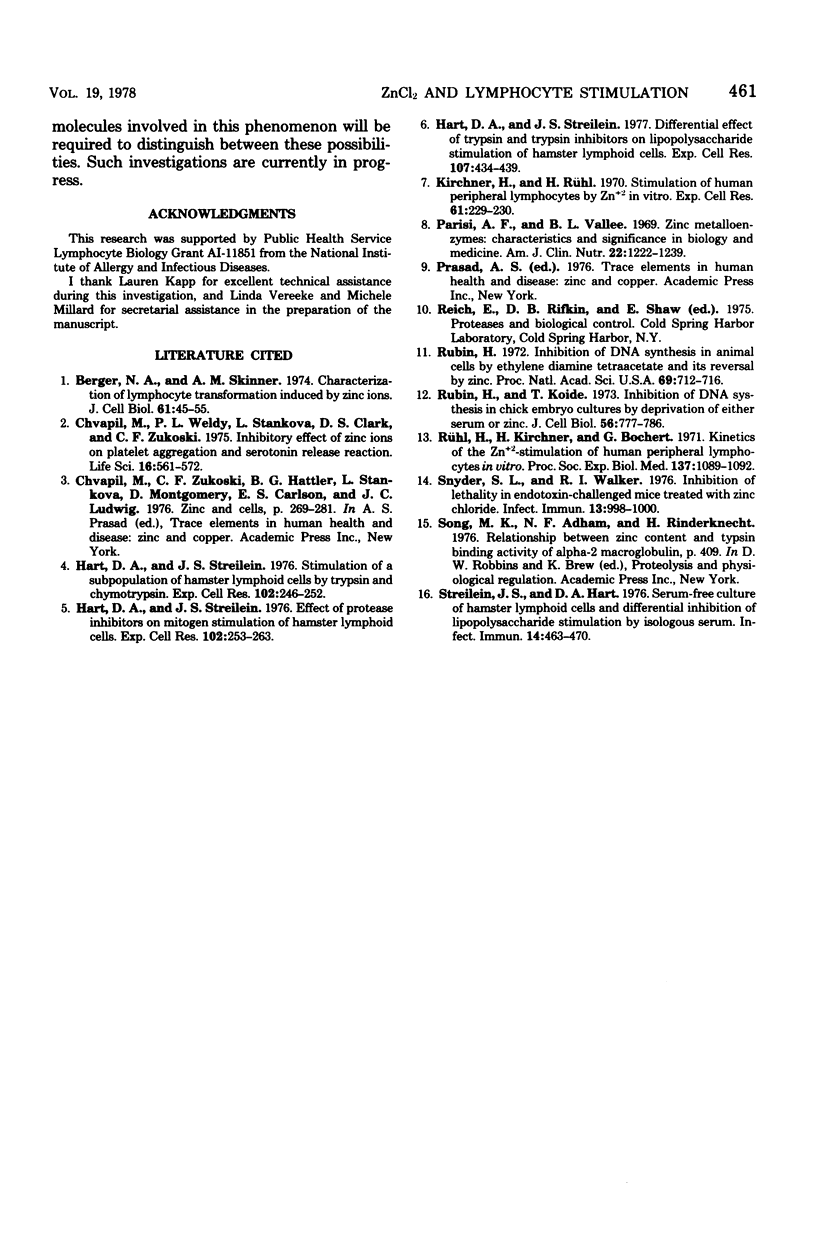Abstract
ZnCl2 over a very narrow concentration range was found to be mitogenic for hamster lymph node cells but not for thymocytes or splenocytes. Maximal leucine, [3H]uridine, and [3H]thymidine incorporation. Addition of 10 micron ZnCl2 was found to greatly enhance the stimulation observed with the B-lymphocyte mitogen lipopolysaccharide but not with dextran sulfate or the T-lymphocyte mitogen lipopolysaccharide but not with dextran sulfate or the T-lymphocyte mitogen concanavalin A. Although not mitogenic for splenocytes, 10 to 25 micron ZnCl2 slightly enhanced lipopolysaccharide stimulation but not concanavalin A or dextran sulfate stimulation. The effect of ZnCl2 on lipopolysaccharide stimulation was also confirmed with outbred Hartley guinea pig splenocytes and lymph node cells. Zinc chloride (50 micron) was mitogenic for both of these tissues; the response to lipopolysaccharide was enhanced by addition of 50 micron ZnCl2, but the concanavalin A response was unaffected. The possibility that the zinc effect is mediated by proteolytic mechanisms is discussed.
Full text
PDF




Selected References
These references are in PubMed. This may not be the complete list of references from this article.
- Chvapil M., Weldy P. L., Stankova L., Clark D. S., Zukoski C. F. Inhibitory effect of zinc ions on platelet aggregation and serotonin release reaction. Life Sci. 1975 Feb 15;16(4):561–571. [PubMed] [Google Scholar]
- Hart D. A., Streilein J. S. Differential effect of trypsin and trypsin inhibitors on lipopolysaccharide stimulation of hamster lymphoid cells. Exp Cell Res. 1977 Jul;107(2):434–439. doi: 10.1016/0014-4827(77)90366-4. [DOI] [PubMed] [Google Scholar]
- Hart D. A., Streilein J. S. Effect of protease inhibitors on mitogen stimulation of hamster lymphoid cells. Exp Cell Res. 1976 Oct 15;102(2):253–263. doi: 10.1016/0014-4827(76)90040-9. [DOI] [PubMed] [Google Scholar]
- Hart D. A., Streilein J. S. Stimulation of a subpopulation of hamster lymphoid cells by trypsin and chymotrypsin. Exp Cell Res. 1976 Oct 15;102(2):246–252. doi: 10.1016/0014-4827(76)90039-2. [DOI] [PubMed] [Google Scholar]
- Kirchner H., Rühl H. Stimulation of human peripheral lymphocytes by Zn2+ in vitro. Exp Cell Res. 1970 Jul;61(1):229–230. doi: 10.1016/0014-4827(70)90284-3. [DOI] [PubMed] [Google Scholar]
- Parisi A. F., Vallee B. L. Zinc metalloenzymes: characteristics and significance in biology and medicine. Am J Clin Nutr. 1969 Sep;22(9):1222–1239. doi: 10.1093/ajcn/22.9.1222. [DOI] [PubMed] [Google Scholar]
- Rubin H. Inhibition of DNA synthesis in animal cells by ethylene diamine tetraacetate, and its reversal by zinc. Proc Natl Acad Sci U S A. 1972 Mar;69(3):712–716. doi: 10.1073/pnas.69.3.712. [DOI] [PMC free article] [PubMed] [Google Scholar]
- Rubin H., Koide T. Inhibition of DNA synthesis in chick embryo cultures by deprivation of either serum or zinc. J Cell Biol. 1973 Mar;56(3):777–786. doi: 10.1083/jcb.56.3.777. [DOI] [PMC free article] [PubMed] [Google Scholar]
- Rühl H., Kirchner H., Bochert G. Kinetics of the Zn 2+ - stimulation of human peripheral lmphocytes in vitro. Proc Soc Exp Biol Med. 1971 Jul;137(3):1089–1092. [PubMed] [Google Scholar]
- Snyder S. L., Walker R. I. Inhibition of lethality in endotoxin-challenged mice treated with zinc chloride. Infect Immun. 1976 Mar;13(3):998–1000. doi: 10.1128/iai.13.3.998-1000.1976. [DOI] [PMC free article] [PubMed] [Google Scholar]
- Streilein J. S., Hart D. A. Serum-free culture of hamster lymphoid cells and differential inhibition of lipopolysaccharide stimulation by isologous serum. Infect Immun. 1976 Aug;14(2):463–470. doi: 10.1128/iai.14.2.463-470.1976. [DOI] [PMC free article] [PubMed] [Google Scholar]


